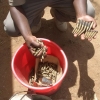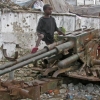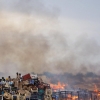We have an Arms Trade Treaty!
Saferworld has been working for a global Arms Trade Treaty (ATT) for nearly 20 years. On 2 April 2013 the text of an ATT was finally agreed at the UN General Assembly. This historic treaty has the potential to regulate the global arms trade and reduce the suffering and loss of life that can result from irresponsible and poorly regulated arms transfers.
When it finally happened, the resolution to adopt the treaty was passed by the UN General Assembly with 155 votes in favour, 3 against, and 22 abstentions (after Angola's mistaken abstention on the day was amended). But this ground-breaking treaty is the result of intensive negotiations over two diplomatic conferences, which themselves were the culmination of seven years of work in the UN, and nearly 20 years of hard work by civil society and progressive states to better control the global arms trade. It was immensely satisfying to see the positions of major states such as China and the US, once apparently implacably opposed to key aspects of the eventual treaty, shift as the negotiations progressed.
Saferworld has been at the heart of this work since the start, being part of a small group of organisations that conceived the idea of a global treaty. We then helped to establish and work with a global civil society campaign, Control Arms. Our technical expertise in arms transfer control issues and our contribution to ATT advocacy over the years has complemented the efforts of our partners in the North and South to mobilise and influence public and political opinion to deliver a treaty. The shared expertise of Saferworld and the coalition provided efficient and rapid analytical, legal and technical support to states, as well as sometimes being their fiercest critics. Through the coalition we also successfully motivated people around the world to support the aim of a treaty through research, advocacy, and campaigning.
One of the strongest elements of the ATT is that it prohibits states from transferring arms that they know would be used to commit genocide, crimes against humanity, and war crimes. These prohibitions apply to all conventional arms covered by the treaty, as well as ammunition and munitions, and parts and components, a scope that for many years seemed unattainable.
However, agreeing the treaty is only the start. How much impact it will have rests on it being signed and ratified, and then interpreted and implemented in a progressive way. Saferworld is now working to ensure that as many states as possible do this, and apply the treaty in a way that makes a difference to the lives of those at the sharp end of this trade.
“It was immensely satisfying to see the positions of major states such as China and the US, once apparently implacably opposed to key aspects of the eventual treaty, shift as the negotiations progressed.”
Saferworld







